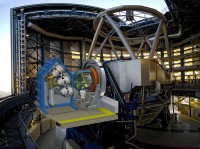Edinburgh astronomers to lead €9m space project

Scientists at the Royal Observatory Edinburgh will spearhead efforts to probe the distant reaches of the early Universe using a powerful new telescopic tool.
Stargazing power
Edinburgh astronomers will lead on the development of MOONS (Multi Object Optical and Near-infrared Spectrograph), a new instrument that will boost the stargazing powers of the Very Large Telescope (VLT) in northern Chile.
The VLT is the world’s most productive ground-based astronomical facility. MOONS will be used to tackle some of the most compelling astronomical puzzles, such as how stars and galaxies form and evolve, and to probe the structure of the Milky Way. It will allow astronomers to see obscured areas in the Milky Way at a distance of around 40,000 light years away, and enable them to create a 3D map of our galaxy.
Researchers at the UK Astronomy Technology Centre (UK ATC), based at the Observatory, will manage the multinational consortium that will construct MOONS. The instrument is scheduled to become operational by 2019.
“MOONS is a unique instrument able to pioneer a wide range of galactic, extragalactic and cosmological studies and provide crucial follow-up for major facilities such as Gaia, the Visible and Infrared Survey Telescope for Astronomy (VISTA), Euclid and the Large Synoptic Survey Telescope (LSST). I am hugely proud of the dedication and skill demonstrated over the project’s selection stages by our engineers and scientists at the UK ATC and across the consortium. We look forward to building this exceptional piece of technology and paving the way for many discoveries.”
Dr Michele Cirasuolo, School of Physics and Astronomy and Principal Investigator of MOONS project
Like any spectrograph, MOONS will use the colour of light emitted by objects to reveal their chemical composition, mass, speed and other properties. Breaking new ground by simultaneously observing 1000 objects using fibre-optic cables to feed their visible and infrared light into the instrument, it will survey large samples of objects far faster than any existing instrument and conduct surveys that would be virtually impossible using today’s technologies. Not surprisingly, the design will pose extraordinary technical demands. For example, each of the 1000-plus fibres will have to move into position very quickly, with great accuracy and without colliding with each other.
VLT platform
In collaboration with the University of Cambridge and other UK universities, the UK ATC’s world-leading expertise in fields such as miniaturised mechanics and precision optics will be harnessed on key aspects of the project. The UK ATC will develop the most innovative component, the individual motorised systems allowing each fibre to move rapidly into position. It will also develop the cryostat system (used to cool MOONS down to -170°C) vital to enabling the infrared observations needed to penetrate galactic and intergalactic dust clouds. The University of Cambridge will develop complex cameras capable of meeting the instrument’s demanding performance requirements.
Once MOONS is up and running, the international consortium will receive 300 nights of observations using the instrument. In particular, this will benefit two ground-breaking projects: one to produce an unprecedented sophisticated survey of the centre of the Milky Way; the other to look far back in time at ultra-distant galaxies to uncover the secrets of their early evolution. For more information, visit the ROE website.
UK ATC
Based at the Royal Observatory in Edinburgh and operated by STFC, the UK Astronomy Technology Centre (UK ATC) is the national centre for astronomical technology. The UK ATC designs and builds instruments for many of the world’s major telescopes. It also project-manages UK and international collaborations and its scientists carry out observational and theoretical research into questions such as the origins of planets and galaxies. The UK ATC has been at the forefront of previous key initiatives at the VLT, including the construction of KMOS (K-band Multi-Object Spectrograph) which enables 24 objects to be observed simultaneously in infrared light.
Very Large Telescope
The Very Large Telescope (VLT) is the world's most advanced optical instrument, consisting of four Unit Telescopes with main mirrors 8.2m in diameter and four movable 1.8m diameter Auxiliary Telescopes. The telescopes can work together to form a giant ‘interferometer’, the ESO Very Large Telescope Interferometer (VLTI), allowing astronomers to see details up to 25 times finer than with the individual telescopes. The Unit Telescopes can also be used individually. With one such telescope, images of celestial objects as faint as magnitude 30 can be obtained in a one-hour exposure, corresponding to seeing objects four billion times fainter than can be seen with the unaided eye.

